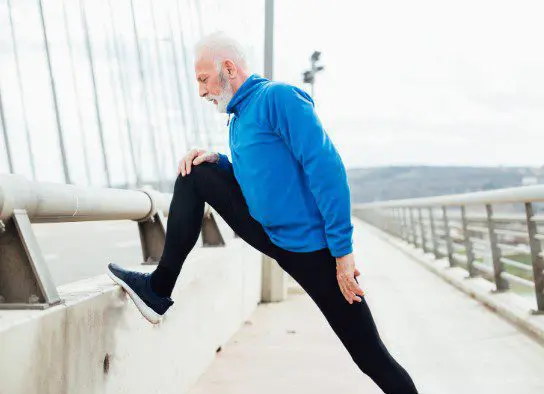
Overall, knee prosthesis implantation is one of the most successful operations of all, particularly in terms of pain reduction and restoration of function
The right amount of self-therapy
In the first week after the operation, the swelling of the knee joint on the shelf increases. During this time, you should not do too much activity so as not to provoke swelling and pain. These two parameters are somewhat of a guard rail for the knee joint’s ability to bear weight in the initial period.
If the pain and swelling are well, start doing the instructed exercises 2-3 times a day. The brochure provided will help you with this.
Go for regular walks and continuously increase the distance, stride length and walking speed. At home, try to gradually stop using walking sticks and take a few steps without walking aids. In the first week, you should not walk more than 1000 steps per day. You can then gradually increase this.
However, the joint also needs regular rest. Elevate it regularly and apply cooling compresses such as curd compresses. Wear the compression stocking (if available) during the day to minimize swelling and pain. The stocking can serve you well for several weeks.
Pain, especially at night, is not uncommon within the first 2 months after surgery. After 2 months, our patients have on average regained their normal everyday activities, and after 3 months they can start doing light sport again. However, rehabilitation is always somewhat individual, also depending on the initial conditions.
Outpatient physiotherapy
As a rule, further follow-up treatment is supported by outpatient physiotherapy, most easily in the vicinity of your place of residence. When you are discharged from hospital, you will receive an initial prescription from us.
The primary aim is to restore the function of the knee joint and relieve pain so that you are able to cope with everyday life independently again as soon as possible. A tolerable level of pain is important for further rehabilitation and is the top priority. The next step is to start building up your muscles again and training your gait.

As this is an artificial joint, you will also need to develop a new “feel” for your joint, which is also practiced in coordination with physiotherapy. If there is excessive swelling, lymphatic drainage may also be prescribed. It is usual that you will need physiotherapy for 2-4 months. Depending on your history and initial situation, this may take even longer.
Follow-up checks
We are your first point of contact in the event of any wound healing problems, so please contact the practice without delay! Prescriptions for painkillers, thrombosis prophylaxis and physiotherapy will also be issued by us and given to you when you leave hospital.
We are also available for routine surgical follow-up care to ensure proper rehabilitation and a good result after joint replacement.
The first consultation usually takes place after 14 days for a wound check . The next check-up with X-ray is after 2 months. If you and we are already satisfied with your results, a final check-up with X-ray is due 1 year after the operation. If there are still residual symptoms, we would like to see you for an additional check-up after 4 months and more if necessary. In the further course, check-ups are only necessary if new complaints arise.
Prospects of success and risks
Around 20,000 knee prostheses are implanted in Switzerland every year, making it a routine operation. Overall, the risk of complications from the operation is very low at 1-2% and sports activities can usually be resumed with a knee prosthesis.
New knee prostheses increasingly resemble the natural knee joint. However, they are still only an approximation of nature! A knee prosthesis therefore remains a replacement with certain compromises.
For example, some residual pain is not unusual during exercise. The average patient indicates a pain level of 1-2 points on a scale of up to 10 during heavy exertion. Kneeling is often only possible to a limited extent due to the scar.
In principle, sporting activities are possible with a knee prosthesis. Most of our patients can ski, cycle, play golf or go hiking without any problems. However, the artificial joints wear out somewhat more quickly, especially in very active patients. According to the current state of the art, the artificial joint can easily survive for over 20 years.
Every operation is always associated with certain risks of complications. The most important risk factor today is primarily the patient himself or herself, who carries a personal surgical risk due to age and secondary illnesses. For example, diabetes, rheumatic disease, anemia or significant obesity are associated with a higher risk of complications, particularly with regard to wound healing disorders or infections. Taking blood-thinning medication carries a risk of secondary bleeding.